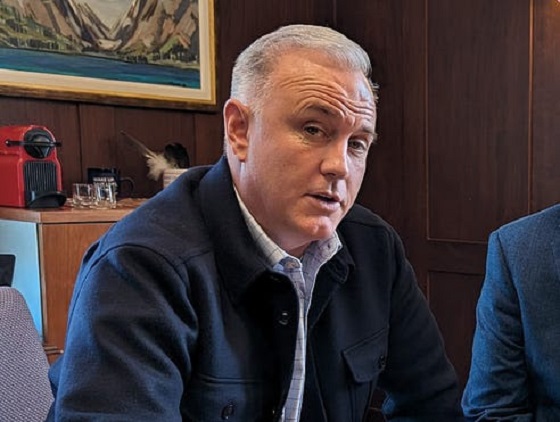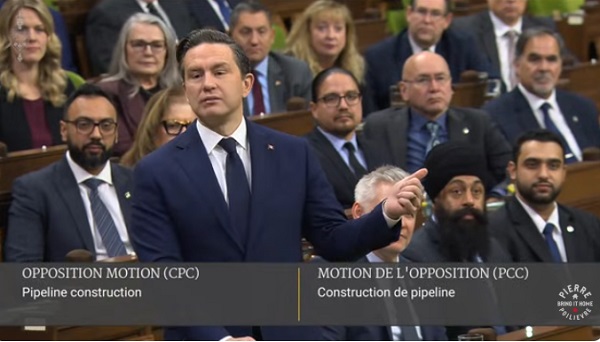Addictions
Alberta and opioids II: Marshall Smith’s ambitious campaign

Marshall Smith. Photo: PW
Click here to subscribe to The Paul Wells Newsletter.
Alberta’s system builder
The Alberta model, made in BC
“I, as you know, have been everywhere in this field, from eating out of garbage cans to this office,” Marshall Smith said. “So I have a deep respect for everybody who works along that continuum.”
We were sitting in the office at the Alberta Legislature reserved for chiefs of staff to Alberta premiers. That’s Smith’s current job. Premier Danielle Smith was probably nearby, though I didn’t see her on this trip. On a shelf behind Marshall Smith were two coffee mugs of different design, each bearing the inscription WAKE UP. SAVE LIVES. REPEAT.
Thank you for reading Paul Wells. This post is public so feel free to share it.
Anyway, Marshall Smith (all future uses of “Smith” in this post will refer to him, unless I specify the premier) was talking about the continuum from dumpsters to the centre of power. “Where you work on that continuum obviously colours the way that you enter this conversation,” he said. “When you are standing on a sidewalk with a person in front of you, the solutions to that person’s problem look very different than what you might do to plan a broader system of care, for a large population of people.”
This was his way of anticipating criticisms he faces as a leading strategist behind Alberta’s emerging strategy for handling a deadly progression in opioid doses. Since he entered Alberta’s government as a more junior staffer in the government of former premier Jason Kenney in 2019, Smith has been working to put a much greater emphasis on recovery from addiction than on “harm reduction,” whose valuable goal is to keep drug users alive whether they recover or not. This makes him a bête noire among harm-reduction advocates. (You can read a mild critique of his efforts here; or a real scorcher here).
What Smith was saying was, in effect, If you work on the street, you’re going to be all about harm reduction, and I respect that. But he is working on drug policy for a whole province, and perhaps beyond, so he needs a broader perspective. “I’m a system builder. So I don’t have the luxury of just focusing on one particular substance. I have to worry about the whole population. I have to worry about the disease burden of addiction and drug use more broadly.”
He sees much to worry about. “Over the last 30 years in Canada, successive governments have failed miserably to anticipate and adequately address the type of services — both from a capital investment and an operating investment — to help people do this.” By “this,” he means escaping addiction. “We have not cared about people with mental health and addiction issues. And we had the ability to not care because up until the last six or seven years, the evidence of them was hidden away.”
Smith first started thinking about this when he was in British Columbia, where he began his recovery from a history of drug use. In 2018, at the BC Centre for Substance Use, Smith co-wrote a report with Dr. Evan Wood that called for a large new investment in facilities and programs to help people recover from addiction. The report is no longer on the BCCSU website, but you can download a copy here.
“It was a 39-point strategy to transform the system in British Columbia,” Smith recalled. “The government of British Columbia wasn’t interested in that strategy. They wanted to go a particular direction.
“So that report is now known as the Alberta model.”
I’m leaving the paywall off these stories because I want them to be widely shared and discussed. But the reason I’m able to report and present big stories like this, with the travel and expenses that involves, is because many of my readers choose to become paying subscribers. If you want to support my work and get full access to everything I write, here’s the button.

Marshall Smith in the dining hall of the Lakeview Recovery Community, opening in July. Photo: PW
In its first page, the Wood/Smith report said “British Columbia has long suffered because of the lack of an effective system to support individuals in and pursuing recovery from substance use disorders.” The system’s “overwhelming focus” was on keeping people alive rather than helping them get better. Wood and Smith wanted that to change.
The need for major new investments in addiction recovery was essentially uncontroversial in B.C. Indeed governments there still periodically announce they are making such investments. But Smith was perpetually unsatisfied with the scale of that commitment.
A year after BC’s new NDP government could-shouldered his report, Smith began working in the UCP government of Alberta’s then-new premier, Jason Kenney.
“Obviously we started off very modestly,” Smith said. “I worked in an office down in the basement. Mental health and addiction wasn’t a big deal. It really was very much a group of cubicles.”
Today, Alberta’s department of mental health and addiction is the seventh-largest ministry in the provincial government.
“The ROSC transformation that is going on in Alberta is massive. It is one of the most massive whole-of-government system transformations that I’ve seen,” Smith said. The premier chairs a ROSC committee of cabinet with seven ministers.
I guess I’d better unpack that acronym. ROSC stands for “recovery-oriented system of care,” a term that appeared in the 2018 report Smith co-wrote.
So you get the premier and her ministers of mental health and addiction, Indigenous relations, advanced education, health, community and social services, public safety and the attorney general meeting regularly to coordinate recovery policy. The premier’s chief of staff is on the file constantly. As I mentioned on Monday, he devoted a full day to explaining this broad effort to me.
“We spend enormous amounts of time and energy,” Smith said. “All of us live and breathe this. Anybody out there that thinks that we’re just, from a conservative perspective, just cavalierly doing this, that just couldn’t be more untrue. We we are in this completely and totally. We monitor almost everything that goes on in the system.”
What are they working on? Smith said the “recovery” part of that “recovery-oriented system of care” jargon-ball gets most of the attention, because it draws attention to the contrast between harm-reduction and abstinence-based recovery models. But Smith is a wonk, and if anything he is more interested in the “system of care” part. His goal is to ensure that every interaction an opioid user has with the modern government apparatus is designed to encourage recovery from dependency. Since people who use drugs tend to bump up against the state a lot, Alberta’s emerging system has a lot of moving parts. The goal is to hook the parts up more effectively.
One of the other men in Smith’s office, Dr. Nathaniel Day, chimed in. He’s been the lead strategist on substance use at Alberta Health Services. He’s an important Smith collaborator.
“Across Canada,” he said, “the system of care for people with addiction has been fragmented, poorly thought out — convenient.” He meant services had generally only been provided when, and where, it was easy for government to provide them. “If you look at opioid dependency treatment, if you lived in a suburban or rural community, it didn’t matter that you had an opioid use disorder. Tough. We had no services for you.”
Day designed the Virtual Opioid Dependency Program, which provides online consultations to patients anywhere in Alberta, and if needed, prescriptions to medications that can be filled at local pharmacies. For patients without coverage, the medication is free and if their local pharmacist has it in stock, available on the day of the call.
“We went in and said, enough is enough,” Day said. “What would be good enough for you and your family? And how do we take that to everybody?”
Which medication? “In this province, we’re huge fans of gold-standard opioid-replacement medications, and we use it a lot,” Smith said. “We have Sublocade, which is something that other provinces don’t have because it’s very expensive. It’s the injectable version of Suboxone. It’s a subcutaneous injection, it goes under the skin, it lasts for 30 days, where the oral is 24-hour. So that’s a thousand bucks a shot, and we pay for that.”
An obvious point about this is that these so-called opioid agonist treatments, or OATs, are big-time harm reduction. They greatly reduce both withdrawal symptoms and highs. One question that I still have, after watching everything Smith and the Alberta government are doing on drug recovery, is whether other provinces could afford to match it.
Running into those institutions
VODP is useful for people who are able to reach out for help from home. But other potential beneficiaries are distracted, or in distress. Very often they run into the police.
“So we took that technology” — the virtual access to physicians and treatment — “and we gave it to the 34 police agencies that we have in the province,” Smith said.
“We said to the officers, ‘If you encounter somebody who has an opioid-use disorder, you can get them started on opioid-use medication. You can, officer. Here’s the phone number to call. Put them on. We make the arrangements. They go to the pharmacy, right then and there. If they’re on the street, that can be done right in the back of a police car.
“If they are in custody at the cell block and they go into the cell block, we have put paramedics in every cell block in Alberta. So the first thing that happens to somebody when they’re arrested and they go into into municipal cells, they’re met by a paramedic that says, ‘Let’s talk about your substance use. Are you an opioid user? We can offer you immediate treatment right now. Right here. Would you like to do that?’ Through our police programs, we’re probably up to like 4,000 people who have taken us up on that.”
That’s what you can get done in a police cruiser or a holding pen. Lots of people go much further into the correctional system than that. So does Smith’s system of care.
“[Alberta’s] focus on corrections and police right now, admittedly, is the opposite of what some other jurisdictions are focusing on,” Smith said. If anything this was an understatement. A major argument for decriminalization and safe supply is that the last thing a drug user needs is the stigma of a criminal record. Other jurisdictions, Smith said, “are running away from those institutions when they should be running into those institutions.
“I’ll give you a very direct example why.
“We know, from the 2017 coroner’s report in Alberta that 40 percent of the people who died [of opioid-related causes] were in custody in the year prior to their death. That’s a really important piece of information, because it tells me I have a big chunk of population there that — if I can get at them, and if we can change the way that they experience this process — we can make a big dent in these numbers.”
A lot of people in the correctional system have substance-use disorder, even if that’s not what they’re in for. “We said, ‘Let’s really do a different way of thinking on this,’” Smith said. “Even though Corrections is a public-safety agency, we want the Ministry of Mental Health and Addiction to take over all Corrections health care.”
Perhaps four in five detainees, he said, “have alcoholism, addiction and mental-health issues. They’re all pooled up in one place and they’re not doing anything. They’ve got nothing but time on their hands. And I don’t have to build a new building? You’re kidding me! This is fantastic! Why wouldn’t I just put therapists in? So we now have treatment programs inside correctional centers.”
Of course a lot of places do programs for inmates. “But what they’re going to show you when you unpack that is, ‘Well, we give them this workbook,’” Smith said. “What they’re not doing is the deep transformative, therapy work that is necessary. And honestly, Paul, our Therapeutic Living Units are probably the best treatment programs we have in Alberta.”
With that, we piled into Smith’s SUV — Smith, Day and the third member of Smith’s team that day, a physician and consultant named Dr. Paul Sobey. A half-hour later we arrived at the Fort Saskatchewan Correctional Centre, northeast of Edmonton.
Here we visited the Therapeutic Living Unit, a full-time addiction-recovery program for 21 women who are housed separately from the general inmate population. That’s about 10% of the total population of women at Fort Saskatchewan. The program opened in February. Participants, who must apply, run through a 12-hour daily program of activity: morning check-in meetings, physical exercise, twice-daily smudge ceremonies reflecting the large Indigenous population in the correctional system, frequent meetings of Alcoholics Anonymous and Narcotics Anonymous as well as the more recently developed SMART Recovery system. Participants are rarely alone during daylight hours. The program is designed to last for months, which struck me as an unusually long time for a recovery program.
Four of the program’s participants sat on a sofa and talked about their experience in the program. “I’ve been wondering and wondering if a program like this was going to happen,” one said.
“It’s like an answered prayer, honestly,” said another. “So I would just encourage you to keep opening places like this.”
That’s the plan. “We’ve got 12 correctional centers in Alberta,” Smith told me before our road trip. “Our goal is to have Therapeutic Living Units [in all of them]. There will come a time where we have whole correctional centers that are working on this model, right? This requires massive intervention, not tinkering around the edges. This is generational change in the way that we do corrections in Alberta.”
Connections
All of the four young women we heard from said they’re nervous about what happens when they get out of detention. Old acquaintances can encourage a return to old habits. Which is part of the reason why Alberta is also building a network of live-in Recovery Communities, long-term residential rehab programs to reinforce the lessons learned in the TLUs — or to help other people begin recovery if they didn’t arrive via the correctional system.
Once the system is fully built in 2027, “every correctional centre will have a sister Recovery Community,” Smith said. “That’s why we’re building 11 of them around the province. Five of them are on First Nations, in partnership with the First Nations.”
Here’s where the system starts to look like a system. After all, in the broadest outlines nothing’s new here. People in prisons have long received addiction counselling, and the Alberta government and various private groups have long run rehabs. But for the longest time, these assorted parts of the system could barely talk to one another. So the chances of a seamless transition from the correctional system to recovery care were lousy. They’re still not great, because the system is still being built, but the goal is a seamless network of care.
“Services in 2018, 2019 were very disconnected,” Warren Driechel, the Edmonton Police Service deputy chief we met the other day, told me. The bureaucratic runaround that we all have to face can be brutal on people with high needs and impaired function. Say you want to get on AISH, an income-support program for people with a medical condition. To do that, you need a doctor’s appointment. To get one, you need identification. To get ID, you need an address.
Public officials are working to provide services that match that complexity.
In January 2021, the EPS launched a “HELP Unit” to refer people to social services instead of just arresting them.
In September 2023, the police replaced the old holding cells where intoxicated people could dry out and then get dumped back on the street with an Integrated Care Centre where they could connect with social services that operate right in the centre.
And in January 2024, after many of the tent encampments were dismantled, a new Navigation and Support Centre became the city’s hub for providing medical, legal and bureaucratic help for people who have often been bereft.
The Nav Centre has nine shelter beds in the back where people can rest, if needed, while on-site staff and volunteers process their files. (Pets are welcome, unlike in some of the city’s shelters.) The centre has the province’s only on-site Service Alberta photo-ID station. On the day I visited, the Nav Centre assisted 50 people, with 24 visiting the desk run by the Hope Mission, 10 being helped by staff from Radius Health, 12 by the provincial department of mental health and addiction.
Everything old is new
Our final stop was the Lakeview Recovery Community outside Gunn, northwest of Edmonton. When it opens in July, it’ll be the third or fourth in a network of such long-term residential programs. Lethbridge and Red Deer have been open for a while. The goal is to have 11 centres up and running across the province by 2027. Smith hopes that once the full network of centres is open, long wait times in Red Deer and Lethbridge will shrink, perhaps to the point where some beds will be available on-demand.
Each recovery community has its quirks. Lakeview will be for men only. Five of the centres will be on Indigenous land. The minimum stay will be four months, with some residents staying for up to a year. That’s a long stint for a rehab; in some private rehabs, it’s unusual to stay for even a month. In theory every day you spend with a combination of counselling, group therapy, twelve-step programs and medical care will increase your chances of success. No resident will pay for their stay at any recovery community. It’s covered by the government.
Work crews have been renovating the Lakeview site since 2022. It’s an impressive place, roomy and bright, with rooms where residents can meet visiting family, a huge kitchen where residents will learn cooking skills, and a dispensary for opioid agonist treatment. Residents will share bungalows while they’re in the program, five or six to a house.
But it didn’t just come into existence. What’s now Lakeview began its existence as the McCullough Centre for homeless World War II veterans. It had been operating for years as an addiction rehab centre when Jason Kenney’s government closed it in 2021. When the government announced the site’s eventual reopening barely a year later, observers were baffled. Closing the centre fit a narrative about a government that put the bottom line over Albertans’ wellbeing. Refurbishing and reopening it was.. harder to explain. Fitting it into a network of nearly a dozen such centres that will, themselves, be better connected to street-level services and to the corrections system… well, we’ll see, won’t we?
I’m conscious of ending this installment in my series on opioids in Alberta on an ambivalent note. I simply don’t know how this will turn out. My first article, earlier this week, was about the scale of the challenge. This one is about the scale of the response. It’s impressive. It’s getting attention across the country. Sobey, the physician who was the third member of our little party as we toured the region’s facilities, has a consulting firm whose aim is to design recovery-oriented systems of care to any government that wants to start the conversation. His phone pinged with an inquiry from another provincial government while we were visiting the Fort Saskatchewan prison. These ideas may come soon to a province near you.
What we don’t know yet is whether they’ll work, or how well. In the third and final installment in this series, I’ll discuss a few reasons to reserve judgment.
But what Alberta is trying is, in many ways, not heretical. Nobody thinks it’s great design to leave desperate people to wander helplessly thorugh a piecemeal hodge-podge of social services and treatment options, with police and corrections hovering over it all as an aloof menace. Smith, his boss the premier, and several government departments are trying to build a better system.
There is room for many devils in the details. But if federalism is supposed to be a laboratory for testing different approaches to thorny problems, Alberta is testing this approach ambitiously. Watching Marshall Smith, I found myself wondering what other intractable governance problems could benefit from the sustained attention of an empowered senior staffer, a supportive head of government, and ministers and public servants working in close coordination.
For the full Paul Wells experience, upgrade your subscription.
Addictions
Manitoba Is Doubling Down On A Failed Drug Policy

From the Frontier Centre for Public Policy
Manitoba is choosing to expand the same drug policy model that other provinces are abandoning, policies that normalize addiction while sidelining treatment, recovery, and public safety.
The New Democrat premier of British Columbia, David Eby, stood before reporters last spring and called his government’s decision to permit public drug use in certain spaces a failure.
The policy was part of the broader “harm reduction” strategy meant to address overdose deaths. Instead, it had stirred public anger, increased street disorder and had helped neither users nor the communities that host them. “We do not accept street disorder that makes communities feel unsafe,” Eby said. The province scrapped the plan.
In Alberta, the Conservative government began shutting down safer-supply prescribing due to concerns about drug diversion and misuse. The belief that more opioids can resolve the opioid crisis is losing credibility.
Ontario Progressive Conservatives are moving away from harm reduction by shutting down supervised consumption sites near schools and limiting safer-supply prescribing. Federal funding for programs is decreasing, and the province is shifting its focus to treatment models, even though not all sites are yet closed.
Yet amid these non-partisan reversals, Manitoba’s government has announced its intention to open a supervised drug-use site in Winnipeg. Premier Wab Kinew said, “We have too many Manitobans dying from overdose.” True. But it does not follow that repeating failed approaches will yield different results.
Reversing these failed policies is not a rejection of compassion. It is a recognition that good intentions do not produce good outcomes. Vancouver and Toronto have hosted supervised drug-use sites for years. The death toll keeps rising. Drug deaths in British Columbia topped 2,500 in 2023, even with the most expansive harm reduction infrastructure in the country. A peer-reviewed study published this year found that hospitalizations from opioid poisoning rose after B.C.’s safer-supply policy was implemented. Emergency department visits increased by more than three cases per 100,000 population, with no corresponding drop in fatal overdoses.
And the problem persists day to day. Paramedics in B.C. responded to nearly 4,000 overdose calls in July 2024 alone. The monthly call volume has exceeded 3,000 almost every month this year. These are signs of crisis management without a path to recovery.
There are consequences beyond public health. These policies change the character of neighbourhoods. Businesses suffer. Residents feel unsafe. And most tragically, the person using drugs is offered little more than a cot, a nurse and a quiet signal to continue. Real help, like treatment, housing and purpose, remains out of reach.
Somewhere along the way, bureaucracies stopped asking what recovery looks like. They have settled for managing human decline. They call it compassion. But it is really surrender, wrapped in medical language.
Harm reduction had its time. It made sense when it first emerged, during the AIDS crisis, when dirty needles spread HIV. Back then, the goal was to stop a deadly virus. Today, that purpose has been lost.
When policy drifts into ideology, reality becomes an afterthought. Underneath today’s approach is the belief that drug use is inevitable, that people cannot change, that liberty means letting others fade away quietly. These ideas do not reflect science. They do not reflect hope. They reflect despair. They reflect a politics that prioritizes the appearance of compassion over effectiveness.
What Manitoba needs is treatment access that meets the scale of the problem. That means detox beds, recovery homes and long-term care focused on restoring lives. These may not generate the desired headlines, but they work. They are demanding. They are slow. And they offer respect to the person behind the addiction.
There are no shortcuts. No policy will undo decades of pain overnight. But a policy that keeps people stuck using is not mercy. It is maintenance with no way out.
A government that believes in its people should not copy failure.
Marco Navarro-Genie is vice-president of research at the Frontier Centre for Public Policy and co-author, with Barry Cooper, of Canada’s COVID: The Story of a Pandemic Moral Panic (2023).
Addictions
The Death We Manage, the Life We Forget

 Marco Navarro-Génie
Marco Navarro-Génie
Our culture has lost the plot about what it means to live.
Reading that Manitoba is bringing supervised consumption to Winnipeg got me thinking.
Walk through just about any major Canadian city, and you will see them. Figures bent forward at seemingly impossible angles, swaying in the characteristic “fentanyl fold,” suspended between consciousness and oblivion. They resemble the zombies of fiction: bodies that move through space without agency, awareness, or connection to the world around them. We think of zombies as the walking dead. Health workers and bureaucrats reverse their overdoses, send them back to the street, and call it saving lives.
At the same time, Canada offers medical assistance in dying to a woman who cited chemical sensitivities and the inability to find housing. It has been offered to veterans who asked for support and were met instead with an option for death. We fight to prevent one form of death while facilitating another. The contradiction is not accidental. It reveals something about the people involved and the funding behind it. That’s our culture. Us. It appears to me that our culture no longer knows what life is.
Ask any politician or program bureaucrat, and you will hear them explain, in the dry language of bureaucracy, that the twin approach to what they call harm reduction and medical assistance in dying (MAiD) rests on the shared premise of what they believe to be compassion. They think they respect autonomy, prevent suffering, and keep people alive when possible. It sounds humane. It is, in practice, incoherent. Bear with me for a moment.
The medical establishment administers naloxone to reverse overdoses in people who spend as many as twenty hours a day unconscious. They live without meaningful relationships or memories, with little capacity for choice. The technocrats and politicians call that saving lives. They also provide assisted death to people whose suffering comes primarily from poverty, isolation, or lack of housing. There was a time when these factors could, at least in theory, be addressed so that the terminal decision did not need to be made. Now they are accepted as grounds for ending life.
But why is one preference final and the other treated as an error to correct? That question reflects the deeper disorientation.
We saw the same thing during COVID. Elderly people in care homes were left without touch, family, or comfort for days. They often died in solitude, their dementia accelerated by isolation. And those conditions were inflicted upon them in the name of saving their lives. The “system” measured success in preventing infections, not in preserving connections. Je me souviens. Or we should.
There is a pattern here. We have reduced the idea of saving lives to keeping bodies breathing, while ignoring what makes a life human: agency, meaning, development, and relationship. And in doing so, we begin to define life as mere biological persistence. But to define life by the capacity to breathe and perform basic functions is to place ourselves on the same footing as the non-human animals. It is to say, tacitly, that there is no fundamental distinction between a person and a creature. That, too, is a form of forgetting.
To be clear, the argument here is not that hopeless drug users should be administered MAiD. Instead, it is essential to recognize that the intellectual framework behind harm reduction and MAiD must be taken seriously, as it rests on some rationally defensible claims. In an age where most arguments are emotive and unexamined, the mildly logical has become strangely compelling.
It begins with the idea of autonomy. We cannot force others to live by our values. Every person must decide what makes life worth living. To insist otherwise is paternalism.
Then comes pragmatic compassion. People will use drugs whether we approve or not. People will find their lives unbearable, whether we acknowledge it or not. We can support them or moralize while they die.
There is also an emphasis on subjective experience. No one knows another’s pain. If someone says their suffering is intolerable, we are in no position to deny it, they say. If a user would rather face opioids than withdrawal and despair, are we entitled to interfere?
Finally, the comparison to medical ethics: we do not withhold insulin from diabetics who continue to eat poorly. We do not deny cancer treatment to smokers. Medicine responds to suffering, even when the patient has contributed to their condition. Harm reduction, they argue, simply applies that principle to addiction.
These arguments produced tangible benefits, they argue. Needle exchanges reduced HIV transmission. Naloxone kits prevented deaths. Safe injection sites meant fewer people dying alone. MAiD brought relief to those in agony. These were not trivial outcomes. I am aware.
Yet when we look more closely, the very logic that underlies these policies also exposes their fatal limitations.
Addiction undermines choice. It hijacks the brain’s ability to reason, compare, and choose. A person deep in addiction is not selecting between alternatives like someone choosing coffee or tea. The structure of choice, the human will, itself is broken. The addiction decides before the person does. St Augustine knew this. Dostoyevsky knew it too.
And for the empirically minded, the research supports this. In British Columbia, where the “safe supply” model was pioneered, some addiction physicians now say the policy is failing. Worse, it may be creating new opioid dependencies in people who were not previously addicted. A study earlier this year found that opioid‑related hospitalizations increased by about 33 percent, compared with pre‑policy rates. With the later addition of a drug-possession decriminalization policy, hospitalizations rose even more (overall, a 58 percent increase compared to before SOS’s implementation). The study concluded that neither safer supply nor decriminalization was associated with a statistically significant reduction in overdose deaths. This is not freedom. It is a new form of bondage, meticulously paved by official compassion.
Despair disguises itself as autonomy, especially in a spiritually unmoored culture that no longer knows how to cope with suffering. A person requesting assisted death because of chronic, untreatable pain may appear lucid and composed, but lucidity is not the same as wisdom. One can reason clearly from false premises. If life is reduced to the absence of pain and the preservation of comfort, then the presence of suffering will seem like failure, and death will appear rational. But that is not a genuine choice because it is based on a misapprehension of what life is. All life entails pain. Some of it is redemptive. Some of it is endured. But it does not follow that the presence of suffering justifies the conclusion of life.
Someone turning to drugs because of homelessness, abandonment, or despair is often in an even deeper eclipse of the will. Here, there is not even the appearance of deliberation, only the reach for numbness in the absence of meaning. What looks like a decision is the residue of collapse. We are not witnessing two forms of autonomy, one clearer than the other. We are witnessing the breakdown of autonomy in various forms, and pretending that it is freedom.
Biological survival is not life. When we maintain someone in a state of near-constant unconsciousness, with no relationships, no capacity for flourishing, we are not preserving life. We are preserving a body. The person may already be gone. To define life as nothing more than breathing and performing bodily functions is to deny what makes us human. It reduces us to the level of non-human creatures, sentient, perhaps, but without reason, memory, moral reflection, or the possibility of transcendence. It tacitly advances the view that there is no essential difference between a person and a critter, so long as both breathe and respond to some stimuli.
Governments do these things to keep ballooning overdosing deaths down, preferring to maintain drugs users among the undead instead. That reminds me of how the Mexican government hardly moves a finger to find the disappeared, 100,000 strong of lately. For as long ss they’re disappeared, they choose not to count them as homicides, and they feel justified in ignoring the causes of all the killing around them.
Some choices are nefarious. Some choices deserve challenge. Not all autonomous acts are equal. The decision to continue living with pain, or to fight addiction, requires agency. The decision to surrender to despair may signal the absence of it. To say all choices are equal is to empty the word autonomy of meaning.
This reflects a dangerously thin view of the human person that permeates our present. What we now call “harm” is only death or physical pain. What we call good is whatever someone prefers. But people are more than collections of wants.
We should have learned this by now. In Alberta, safer supply prescribing was effectively banned in 2022. Officials cited diversion and lack of measurable improvement. We are forcing some people into treatment because we recognize the impairment of judgement in addiction.
In British Columbia, public drug use was quietly re-criminalized after communities rebelled. This was an admission of policy failure. “Keeping people safe is our highest priority,” Premier David Eby said. Yet safe supply remains. In 2023, the province recorded more than 2,500 overdose deaths. Paramedics continue to respond to thousands of overdose calls each month. This is not success. It is a managed collapse.
Meanwhile, Manitoba is preparing to open its own supervised drug-use site. Premier Wab Kinew said, “We have too many Manitobans dying from overdose… so this is one tool we can use.” That may be so. However, it is a tool that others are beginning to set aside. It is a largely discredited tool. Sadly, in the self-professed age of “Reconciliation” with Aboriginal Canadians, Aboricompassionadians are disproportionately affected by these discredited policies.
The Manitoba example illustrates the broader problem, despite damning evidence. Instead of asking what helps people live, we ask whether they gave consent. We do not ask whether they were capable of it. We ask whether they avoided death. We do not ask whether they found purpose.
We are not asking what might lead someone out of addiction. We are not asking what they need to flourish. We ask only what we can do to prevent them from dying in the short term. And when that becomes impossible, technocracy offers them death in a more organized form, cleanly approved by government. That’s compasson.
The deeper problem is not policy incoherence. It is the cultural despair that skates on the thin ice of meaninglessness. These policies make sense only in a culture that has already decided life is not worth too much. What matters is state endorsement and how it’s done .
It is more cost-effective to distribute naloxone than to construct long-term recovery homes. It is easier to train nurses to supervise injection than to provide months of residential treatment. It is far simpler to legalize euthanasia for the poor and the suffering than to work on solutions that lift them out of both. But is it right?
This is not compassion. It is surrender.
A humane policy would aim to restore agency, not validate its absence. It would seek out what helps people grow in wisdom and self-command, not what leaves them comfortably sedated. It would measure success not in lives prolonged into darker dependency but in persons recovered. In lives better lived.
This vision is harder. It costs time. It requires greater effort. It requires care and what some Christians call love of neighbour. It may require saying no when someone asks for help that could lead to ruin. But anything less is not mercy. It is a slow walk toward death while we leave the “system” to pretend there is no choice.
We did have a choice. We chose shallow comfort over deep obligation. We chose to manage symptoms rather than confront the deeper conditions of our age: loneliness, meaninglessness, despair. And now we live among the results: more, not fewer, people swaying in silence, already gone walking dead.
We might ask what we’ve forgotten about suffering, about responsibility, about what life is. Lives are at stake. True. But when our understanding of life is misdirected, so will be the policies the state gives us.
We are grateful that you’re reading Haultain Research.
For the full experience, and to help us bring you more quality research and commentary,
-

 National1 day ago
National1 day agoLiberal bill “targets Christians” by removing religious exemption in hate-speech law
-

 Crime2 days ago
Crime2 days agoInside the Fortified Sinaloa-Linked Compound Canada Still Can’t Seize After 12 Years of Legal War
-

 Business1 day ago
Business1 day agoLooks like the Liberals don’t support their own Pipeline MOU
-

 Business2 days ago
Business2 days agoThe Climate-Risk Industrial Complex and the Manufactured Insurance Crisis
-

 Health2 days ago
Health2 days agoThe Data That Doesn’t Exist
-

 C2C Journal8 hours ago
C2C Journal8 hours agoWisdom of Our Elders: The Contempt for Memory in Canadian Indigenous Policy
-

 Business22 hours ago
Business22 hours agoConservative MP warns Liberals’ national AI plan could increase gov’t surveillance
-

 Business1 day ago
Business1 day agoCanada Can Finally Profit From LNG If Ottawa Stops Dragging Its Feet







